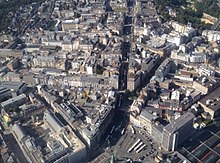Luxembourg railway station
Luxembourg | |
|---|---|
| Commuter, national and international rail services | |
 The station's facade at Place de la Gare is in the traditional Moselle Baroque Revival style. | |
| General information | |
| Location | 11 place de la Gare, L-1616 Gare Luxembourg |
| Coordinates | 49°35′43″N 6°09′33″E / 49.5952°N 6.1592°E |
| Owned by | Luxembourg |
| Operated by | CFL |
| Platforms | 9 |
| Train operators | |
| History | |
| Opened | 4 October 1859 |

Luxembourg railway station (Luxembourgish: Gare Lëtzebuerg, French: Gare de Luxembourg, German: Bahnhof Luxemburg) is the main railway station serving Luxembourg City, in southern Luxembourg. It is operated by Chemins de Fer Luxembourgeois, the state-owned railway company.
80,000 passengers use this station every day.
It is the hub of Luxembourg's domestic railway network, serving as a point of call on all but one of Luxembourg's railway lines (the exception being Line 80, which only stops at one station in Luxembourg). It also functions as the country's international railway hub, with services to all the surrounding countries: Belgium, France, and Germany. Since June 2007, the LGV Est has connected the station to the French TGV network.
The station is located 2 kilometres (1.2 mi) south of the city centre (Ville Haute), to the south of the River Pétrusse. The station gives its name to Gare, one of the Quarters of Luxembourg City.
History

The original railway station was built entirely from timber, and was opened in 1859. The position of the new station on the south bank of the Pétrusse, away from the original built-up area of the city, was on account of Luxembourg's role as a German Confederation fortress. The first connection to the city proper came in 1861, with the construction of the Passerelle viaduct.[1] After the 1867 Treaty of London, the fortifications were demolished, leading to the expansion of the city around the station.
The old wooden station was replaced by the modern building between 1907 and 1913,[1] at the height of an economic boom, fuelled by iron from the Red Lands. The new station was designed by a trio of German architects (Rüdell, Jüsgen, and Scheuffel) in the Moselle Baroque Revival style that dominates Luxembourg's major public buildings.[1] The station lies at the end of the Avenue de la Liberté, one of the city's major thoroughfares, and its imposing clock tower can be seen from a considerable distance.[1]
Modernisation work
In 2006, the Ministry of Transport began a six-year renovation project on Luxembourg station that totaled €95 million. The improvements included new ticketing and sales facilities inside the main hall, expanding platforms, new lifts, a new passenger subway, upgraded overhead electrical wiring, installation of two platform escalators, a new entrance porch, a redesigned forecourt, a glass passenger hall, and a four-storey car park. [2]
Train services
As of December 2017 the station is served by the following services:
- High speed services (TGV) Paris - Metz - Thionville - Luxembourg
- Intercity services Luxembourg - Arlon - Namur - Brussels
- Intercity services Luxembourg - Ettelbruck - Kautenbach - Troisvierges - Gouvy - Liege - Liers
- Intercity services Luxembourg - Wasserbillig - Trier - Koblenz - Köln - Düsseldorf
- Regional services Luxembourg - Wasserbillig - Trier - Koblenz
- Regional services Luxembourg - Ettelbruck - Diekirch
- Regional services Luxembourg - Bettembourg - Esch - Petange - Rodange
- Regional services Luxembourg - Bettembourg - Dudelange - Volmerange-les-Mines
- Regional services (TER Lorraine) Luxembourg - Thionville - Metz - Nancy
- Local services Luxembourg - Ettelbruck - Kautenbach - Wiltz
- Local services Luxembourg - Ettelbruck
- Local services Luxembourg - Wasserbillig
- Local services Luxembourg - Kleinbettingen
- Local services Luxembourg - Bettembourg - Esch - Belval - Petange - Rotange
- Local services Luxembourg - Petange - Rotange - Athus - Longwy
Luxembourg station has some voltage-switchable tracks for Line 50 to Arlon, which is electrified with the Belgian voltage of 3 kV DC. These are due to disappear in 2018
Footnotes
- ^ a b c d "Architectural tour of the railway station district" (PDF). Luxembourg City Tourism Office. Retrieved 2006-11-19.
{{cite web}}: Cite has empty unknown parameter:|month=(help) - ^ "Une nouvelle gare pour fêter son centenaire" [New Station to Celebrate its Centennial]. L'essentiel (in French). Luxembourg. 21 September 2012. Retrieved 2 January 2018.
See also
External links
- Railway stations in Luxembourg City
- Railway stations opened in 1859
- Railway stations on CFL Line 10
- Railway stations on CFL Line 30
- Railway stations on CFL Line 50
- Railway stations on CFL Line 60
- Railway stations on CFL Line 70
- Architecture of Luxembourg
- Railway stations opened in 1913
- 1859 establishments in Luxembourg
